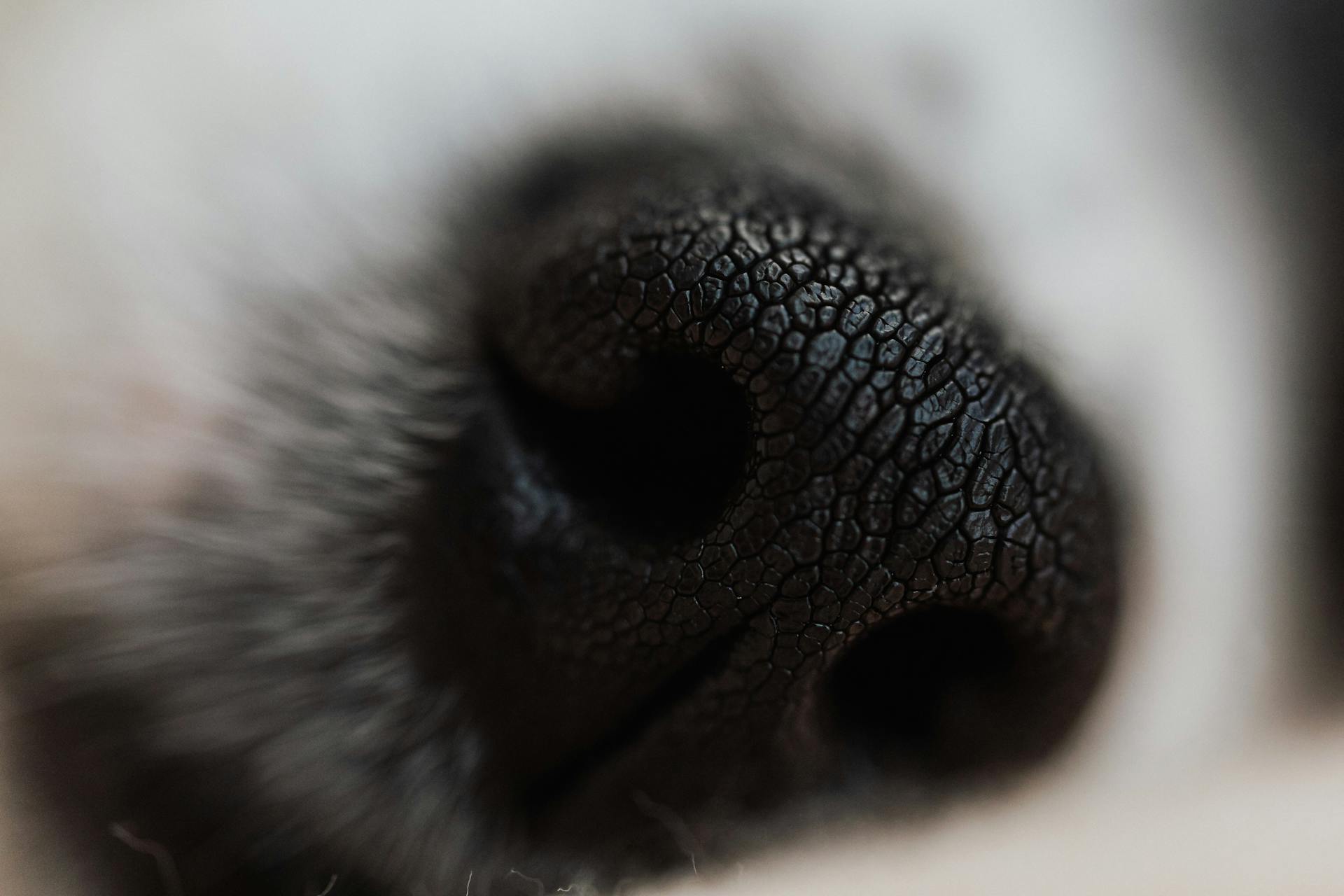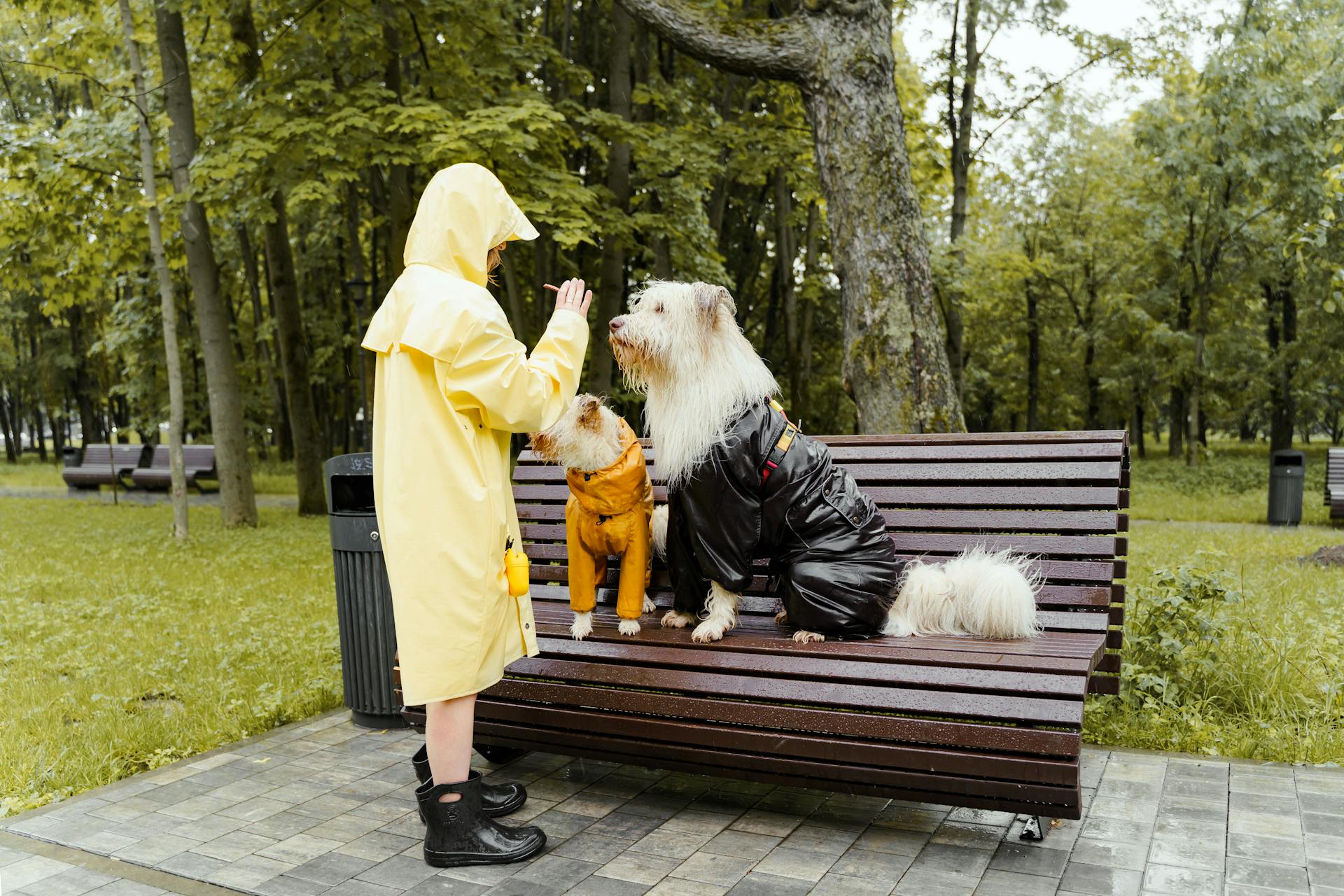
If your dog is changing colors, it's natural to be concerned and wonder what's going on. One possible reason is a condition called vitiligo, which causes the loss of pigment-producing cells in the skin, leading to white patches.
Vitiligo is a relatively rare condition in dogs, but it's more common in certain breeds, such as the Dalmatian. In these breeds, the condition is often inherited.
Dogs with vitiligo may also experience other symptoms, such as skin lesions or inflammation. However, in many cases, the condition is benign and doesn't require treatment.
See what others are reading: Doberman Pinscher Skin Bumps
Causes of Dog Nose Color Changes
Dog nose color changes can be caused by a variety of factors, and it's essential to understand what might be behind the change to ensure your furry friend's health.
Some dog nose color changes are perfectly normal, like the occurrence of "dog snow nose" in winter or cold weather climates, which may be related to temperature or certain enzymes.
Curious to learn more? Check out: Dog Nose Colors
In some cases, a dog's nose color change can be a result of a genetic mutation, leading to a condition known as Dudley nose. This condition causes a permanent loss of pigment in the nose, and it's more common in certain breeds like German Shepherds, Samoyeds, and Dobermans.
Dudley nose isn't necessarily a cause for concern, but it's always a good idea to keep an eye on your dog's overall health.
There are several signs that might indicate a more serious health issue, such as an autoimmune disorder, thyroid condition, or cancer. These include sneezing, nose rubbing, nasal discharge, raised skin, sores, itchiness or irritation around the nose, pawing at the nose repeatedly, cracks, a smoother-than-normal nose texture, or any signs of pain.
If you notice any of these red flags, it's crucial to schedule a vet appointment to rule out any potential health concerns.
Here's a quick rundown of the possible causes of dog nose color changes:
Treatments and Remedies
Steroid ointments can be used to manage symptoms of primary hyperpigmentation in dogs.
Early detection is key, as this allows for more effective management of symptoms.
Special shampoos can also be used to help manage primary hyperpigmentation.
Other medications may be prescribed as symptoms intensify or worsen.
If your dog has secondary hyperpigmentation, treating the underlying issue is crucial.
Anti-fungal medications or antibiotics may be prescribed to treat yeast or bacterial infections.
Medicated shampoos may be recommended for application 2-3 times a week to help treat hyperpigmentation.
Relapse of hyperpigmentation is more likely if the underlying cause hasn't been correctly treated.
Treatment of yeast or bacterial infections, in addition to hyperpigmentation, is essential for dogs with secondary hyperpigmentation.
Your veterinarian can treat any infections that occur in conjunction with hyperpigmentation.
Conditions and Disorders
Hyperpigmentation in dogs can be caused by a variety of conditions, including allergies, hypothyroidism, and Systemic Lupus Erythematosus, a chronic immune-mediated disease.
Some common causes of hyperpigmentation in dogs include:
- Malassezia - A type of yeast infection
- Demodicosis - A condition resulting from the presence of parasitic mites
- Pseudo-Cushing's Syndrome - An endocrine disorder common in middle-aged and older dogs
If your dog is experiencing hyperpigmentation, it's essential to have them checked by a veterinarian to determine the underlying cause and develop an effective treatment plan.
Vitiligo

Vitiligo is a condition where the skin gradually loses pigmentation, causing white patches to appear. This condition can also occur in humans.
Some breeds are more susceptible to vitiligo, including Dachshunds, Doberman Pinschers, Rottweilers, Labrador Retrievers, and German Shepherds. These breeds are more likely to develop vitiligo due to a genetic predisposition.
Vitiligo can affect a dog's entire body, not just the nose. Once a dog's skin starts turning white from vitiligo, the condition isn't reversible. However, a dog with vitiligo is still perfectly healthy, and this condition only affects its appearance.
The pigment-producing cells of the skin, called melanocytes, are destroyed in dogs with vitiligo. This leads to the loss of pigmentation and the appearance of white patches.
Here are some breeds that are more likely to develop vitiligo:
- Dachshunds
- Doberman Pinschers
- Rottweilers
- Labrador Retrievers
- German Shepherds
Hyperpigmentation
Hyperpigmentation is a common condition that can affect dogs of any breed. It's often seen in young Dachshunds, but can occur in any dog.

Primary hyperpigmentation is a rare condition that can occur in any breed, but is more common in Dachshunds under one year old. Secondary hyperpigmentation, on the other hand, is a common symptom that can occur in any dog breed.
Secondary hyperpigmentation is often triggered by inflammation or friction, leading to skin changes like thickened skin, odor, hair loss, and discomfort. It's commonly seen in breeds prone to skin infections, contact dermatitis, and allergies.
Some conditions that can cause hyperpigmentation in dogs include allergies, hypothyroidism, pseudo-Cushing's Syndrome, Systemic Lupus Erythematosus, Malassezia, and Demodicosis.
If your dog has hyperpigmentation, your veterinarian can help diagnose the underlying cause and develop an effective treatment plan. While there's no cure for primary hyperpigmentation, early detection and treatment can manage symptoms with steroid ointments and special shampoos.
Here are some breeds that are prone to secondary hyperpigmentation:
- Basset Hounds
- German Shepherds
- Irish Setters
- Yorkshire Terriers
- Great Danes
- Dobermans
- Labradors
- Dalmatians
- Border Collies
- Lhasa Apsos
- Labrador Retrievers
- Jack Russell Terriers
- Golden Retrievers
- Pugs
In some cases, hyperpigmentation can be a sign of an underlying health concern, such as an autoimmune disorder, thyroid condition, or cancer. If you notice any of the following red flags, make an appointment with your vet:
- Sneezing
- Nose rubbing
- Nasal discharge
- Raised skin
- Sores
- Itchiness or irritation around their nose
- Pawing at their nose repeatedly
- Cracks
- A smoother-than-normal nose texture
- Any signs of pain
Heterochromia Inheritance

Hereditary heterochromia is caused by specific genes, often the same genes that determine coat color.
Scientists have identified 15 genes that play roles in canine coat color phenotypes.
The merle gene is associated with a host of ear and eye disorders, including blindness and deafness.
Dogs with the merle gene are more likely to have heterochromia than dogs without this gene.
The piebald gene, aka white spotting gene, can also result in heterochromia and deafness.
Certain dog breeds are far more prone to having eyes of differing colors than others, including Australian Shepherds, Siberian Huskies, and Great Danes.
Research suggests that perhaps 10% of Siberian Huskies are either bi-eyed or parti-eyed.
The merle gene is an incomplete dominant gene, meaning that only one parent needs the merle gene to pass it along to the next generation.
Unscrupulous breeders may produce blind and/or deaf dogs and pass them off to puppy buyers who are unaware of the additional challenges.
Sources
- https://www.petmd.com/dog/wellness/what-dog-snow-nose-and-what-can-you-do-about-it
- https://medium.com/@jenna_PIR/why-does-my-dogs-nose-change-color-62c3c4cdc102
- https://www.hepper.com/dogs-nose-changing-color/
- https://www.greensboroncvet.com/site/friendly-animal-clinic-blog/2024/02/28/hyperpigmentation-black-spot-dog-skin
- https://www.whole-dog-journal.com/health/what-is-heterochromia-in-dogs/
Featured Images: pexels.com


